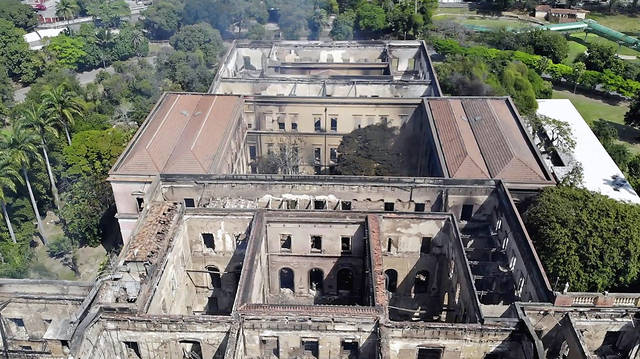RIO DE JANEIRO — Firefighters dug through the burned-out hulk of Brazil’s National Museum on Monday, a day after flames gutted the building, as the country mourned the irreplaceable treasures lost and pointed fingers over who was to blame.
The museum held Latin America’s largest collection of historical artifacts, and the damage was feared to be catastrophic. One official told a Brazilian news outlet that as much as 90 percent may have been destroyed. Some parts of the collection were stored at other sites.
For many in Brazil, the state of the 200-year-old natural history museum quickly became a metaphor for what they see as the gutting of Brazilian culture and life during years of corruption, economic collapse and poor governance.
“It’s a crime that the museum was allowed to get to this shape,” said Laura Albuquerque, a 29-year-old dance teacher who was in a crowd protesting outside the gates. “What happened isn’t just regrettable, it’s devastating, and politicians are responsible for it.”
The cause of the fire that broke out Sunday night was not known. Federal police will investigate since the museum was part of the Federal University of Rio de Janeiro. But protesters, commentators and museum directors themselves said years of government neglect had left the museum so underfunded that its staff had turn to crowdfunding sites to open exhibitions.
Luiz Fernando Dias Duarte, the museum’s deputy director, criticized authorities for starving the museum of vital funding while spending lavishly on stadiums to host the World Cup in 2014.
“The money spent on each one of those stadiums — a quarter of that would have been enough to make this museum safe and resplendent,” he said in an interview in front of the still-smoldering ruins aired on Brazilian television.
Roberto Leher, rector of the Federal University of Rio de Janeiro, said it was well known that the building was vulnerable to fire and in need of extensive repairs. Duarte said he was in the habit of unplugging everything in his office at night because of the risk.
Civil defense authorities were concerned that internal walls and the roof could collapse further, so officials had to wait to conduct a full accounting of losses.
Duarte said that anything held in the main building was likely destroyed. Cristiana Serejo, a vice-director of the museum, told the G1 news portal that as little as 10 percent of the collection may have survived.
The building was once home to the royal family, and the museum’s collection included pieces that belonged to them.
The collection also contained a painting by the Brazilian artist Candido Portinari and extensive paleontological, anthropological and biological specimens. It held a skull called Luzia that was among the oldest fossils ever found in the Americas as well as an Egyptian mummy and the largest meteorite ever discovered in Brazil — one of the few objects that officials could confirm had survived.



